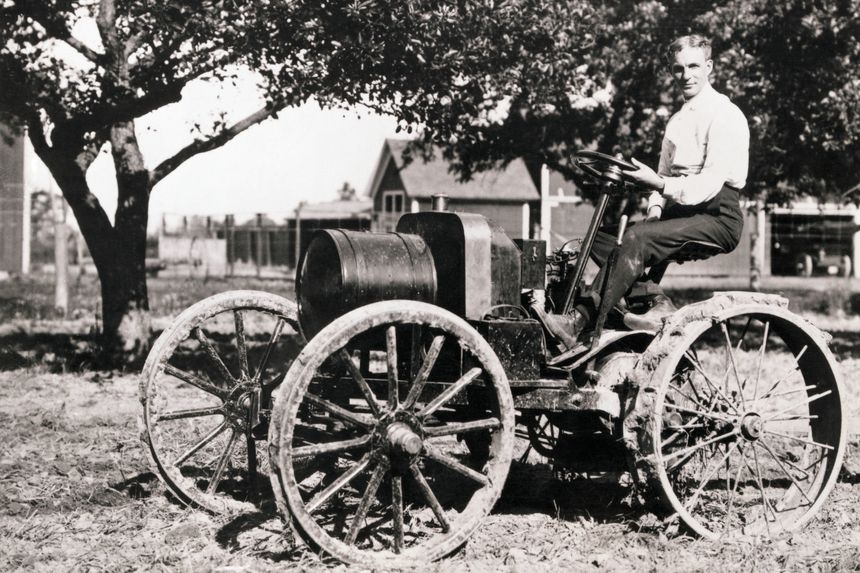By
When one thinks of Henry Ford, one thinks of automobiles. The visionary engineer and entrepreneur all but invented the auto industry when he founded the Ford Motor Co. in 1903. Five years later he manufactured the first affordable car for middle-class Americans, the Model T, having first devised the assembly-line process to mass produce this epoch-making innovation.
Few Americans, however, associate the Ford name with agricultural and farm-class vehicles. Yet years before he conceived the Model T, Ford—who was born on a farm near Dearborn, Mich., in 1863—was obsessed with “making some kind of a light steam car that would take the place of horses,” especially, as he later wrote in his memoirs, “to attend to the excessively hard labour” of plowing, threshing and pulling. Nothing, his first-hand experience had taught him, could be “more inexcusable than the average farmer, his wife, and their children drudging from early morning until late at night.”
The story of Ford’s dream of perfecting an affordable, all-purpose tractor—or, as Ford later imagined it, a gasoline-powered “automobile plow”—is seldom told. Neil Dahlstrom’s “Tractor Wars” tells it well. As the manager of archives and history at John Deere, Mr. Dahlstrom is in a unique position to describe the rise of the tractor in detail, and to follow the arc of both Ford’s ambition to improve American agricultural methods and his rivalry with other farm-vehicle makers.
In 1906, two years before the Model T transformed the American cityscape, Ford asked one of his engineers to develop “a rudimentary tractor built mostly from leftover automobile parts.” Early prototypes contained a Model B engine and transmission, Model K front wheels and radiator, and a grain binder’s rear wheels. It was first demonstrated in 1908, at a fair in Winnipeg, in a pull contest between steam- and gas-powered tractors. Ten years later, the first Model F tractor, built by the Ford subsidiary Fordson, rolled off the assembly line and was delivered to botanist Luther Burbank, in Santa Rosa, Calif.
By 1918 there were many competitors in America’s great tractor pull. Most were small or mid-sized firms, including the Gas Traction Co. of Minneapolis, and the Moline (Ill.) Plow Co. and the Waterloo (Iowa) Gasoline Engine Co. Two ultimately broke out of the pack with loud, gas-guzzling chugs.
The first, International Harvester, was formed in 1902 when the McCormick Harvesting Machine Co. and the Deering Harvester Co. merged with three smaller firms. Enjoying support from financier J.P. Morgan, it instantly became the nation’s fourth-largest corporation, consolidating “85 percent of the harvesting equipment market.” Early attempts by International Harvester to develop a gas-powered tractor were only moderately successful, but in 1920 its engineers made a breakthrough, converting the two front wheels into “traction wheels,” moving the engine from the rear to the middle, and adding three reverse speeds. All of this, plus enhancements to compatible cultivating attachments, made Harvester’s Farmall tractor competitive with the Fordson.

Ford’s other chief rival was the John Deere Co. Its earliest claim to fame was becoming the “world’s largest manufacturer of steel plows.” The company shifted course in 1907 when William Butterworth, the son-in-law of Charles Deere, took control. According to Mr. Dahlstrom, Butterworth was “cautious with the family money that still financed the company, pushing for long-term gains in a cyclical, low-margin, weather-dependent business.” While some outsiders “mistook Butterworth’s preference for steady forward progress as indecision,” his business model turned out to be ingenious.
Recognizing that head-to-head competition with International Harvester would be fruitless, Deere hand-crafted a distinctive product called the “motor plow.” Staff designer Charles Melvin built the first model in 1912, and his colleague Joseph Dain perfected it by adding what became known as all-wheel drive. Although the “continued sheepishness of the banking community” tempered Butterworth’s enthusiasm for tractor development, the company found prestige with its nimble, lightweight—if rather expensive—Tractivator. Then, in 1918, about a month before the first Fordson arrived at Burbank’s doorstep, Butterworth purchased the Waterloo Gasoline Engine Co. This allowed Deere to sell Waterloo Boy tractors until 1923, when the iconic green-and-yellow John Deere Model D tractor was rolled out for all to see.
Appeared in the December 30, 2021, print edition as ‘American Power Pull.’




